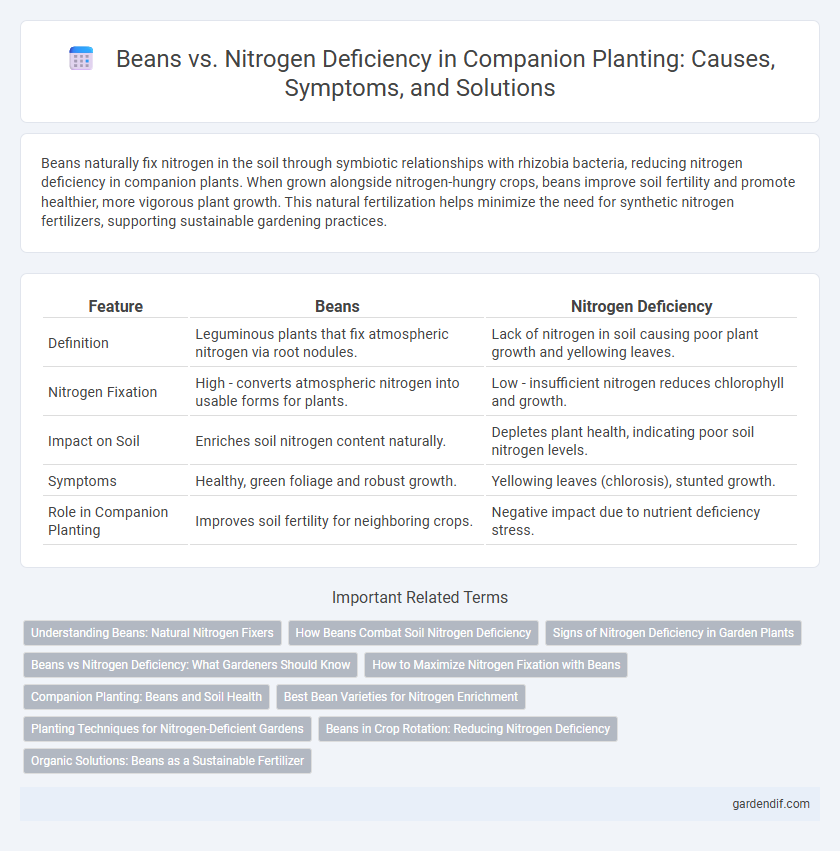
Beans vs nitrogen deficiency Illustration
Beans naturally fix nitrogen in the soil through symbiotic relationships with rhizobia bacteria, reducing nitrogen deficiency in companion plants. When grown alongside nitrogen-hungry crops, beans improve soil fertility and promote healthier, more vigorous plant growth. This natural fertilization helps minimize the need for synthetic nitrogen fertilizers, supporting sustainable gardening practices.
Table of Comparison
| Feature | Beans | Nitrogen Deficiency |
|---|---|---|
| Definition | Leguminous plants that fix atmospheric nitrogen via root nodules. | Lack of nitrogen in soil causing poor plant growth and yellowing leaves. |
| Nitrogen Fixation | High - converts atmospheric nitrogen into usable forms for plants. | Low - insufficient nitrogen reduces chlorophyll and growth. |
| Impact on Soil | Enriches soil nitrogen content naturally. | Depletes plant health, indicating poor soil nitrogen levels. |
| Symptoms | Healthy, green foliage and robust growth. | Yellowing leaves (chlorosis), stunted growth. |
| Role in Companion Planting | Improves soil fertility for neighboring crops. | Negative impact due to nutrient deficiency stress. |
Understanding Beans: Natural Nitrogen Fixers
Beans play a crucial role in sustainable agriculture as natural nitrogen fixers, converting atmospheric nitrogen into usable forms through symbiotic bacteria in their root nodules. This biological nitrogen fixation enhances soil fertility, reducing the need for synthetic fertilizers and preventing nitrogen deficiency symptoms such as stunted growth and yellowing leaves in companion plants. Understanding the nitrogen-fixing ability of beans helps optimize crop rotations and intercropping systems, promoting healthier plant growth and improving overall yield.
How Beans Combat Soil Nitrogen Deficiency
Beans enhance soil fertility by fixing atmospheric nitrogen through symbiotic bacteria in their root nodules, effectively combating nitrogen deficiency. This natural process reduces the requirement for synthetic nitrogen fertilizers, promoting sustainable agriculture. As legumes, beans enrich soil nitrogen content, improving nutrient availability for subsequent crops in rotation systems.
Signs of Nitrogen Deficiency in Garden Plants
Signs of nitrogen deficiency in garden plants include yellowing leaves, especially older foliage, stunted growth, and poor bean pod development. Beans displaying pale green color and reduced leaf size often indicate low nitrogen levels, affecting overall plant vigor. Early detection helps improve soil fertility and supports healthy growth through appropriate fertilization strategies.
Beans vs Nitrogen Deficiency: What Gardeners Should Know
Beans naturally fix atmospheric nitrogen through root nodules, enhancing soil fertility and reducing the need for synthetic fertilizers. However, nitrogen deficiency can cause poor bean plant growth, yellowing leaves, and reduced pod production, signaling gardeners to test soil nitrogen levels. Proper crop rotation and companion planting with beans help maintain balanced nitrogen availability for sustained garden health.
How to Maximize Nitrogen Fixation with Beans
Maximize nitrogen fixation with beans by planting compatible companion crops such as corn or squash, which create a supportive environment for bean root nodules to thrive. Ensure soil conditions are optimal with pH levels between 6.0 and 7.0 and adequate phosphorus and potassium to enhance Rhizobium bacteria activity responsible for nitrogen fixation. Rotate beans with non-leguminous crops to maintain soil health and reduce nitrogen deficiency, increasing overall crop yield.
Companion Planting: Beans and Soil Health
Beans play a vital role in companion planting by naturally fixing atmospheric nitrogen through root nodules containing Rhizobium bacteria, enhancing soil fertility and reducing the need for synthetic fertilizers. When planted alongside nitrogen-demanding crops like corn or leafy greens, beans improve overall soil health by replenishing nitrogen levels, promoting robust plant growth and higher yields. This mutualistic relationship helps prevent nitrogen deficiency in companion plants, supporting sustainable and productive gardening practices.
Best Bean Varieties for Nitrogen Enrichment
Certain bean varieties excel at nitrogen fixation, making them ideal companions for enriching soil nitrogen levels. Varieties such as Crimson Clover, Fava Beans, and Common Beans (Phaseolus vulgaris) demonstrate high nitrogen-fixing capabilities, enhancing soil fertility naturally. Selecting these legumes supports sustainable agriculture by reducing the need for synthetic nitrogen fertilizers.
Planting Techniques for Nitrogen-Deficient Gardens
Planting beans in nitrogen-deficient gardens enhances soil fertility through natural nitrogen fixation, reducing the need for chemical fertilizers. Incorporate crop rotation techniques by alternating beans with nitrogen-demanding crops to maintain soil nutrient balance. Utilize intercropping systems where beans grow alongside cereals, maximizing nitrogen availability and promoting healthier plant growth.
Beans in Crop Rotation: Reducing Nitrogen Deficiency
Beans play a critical role in crop rotation by fixing atmospheric nitrogen through symbiotic relationships with Rhizobium bacteria, thereby enhancing soil fertility and reducing nitrogen deficiency in subsequent crops. Incorporating beans into rotation systems increases nitrogen availability, promoting higher yields and improving soil health over time. This natural nitrogen fixation minimizes dependence on synthetic fertilizers, supporting sustainable agricultural practices.
Organic Solutions: Beans as a Sustainable Fertilizer
Beans naturally fix atmospheric nitrogen through symbiotic bacteria in their root nodules, enriching soil fertility without chemical fertilizers. Their use in organic farming improves soil structure and reduces nitrogen deficiency in subsequent crops. Incorporating beans as companion plants provides a sustainable, eco-friendly solution to maintain nutrient-rich soil and enhance agricultural productivity.
Beans vs nitrogen deficiency Infographic

 gardendif.com
gardendif.com